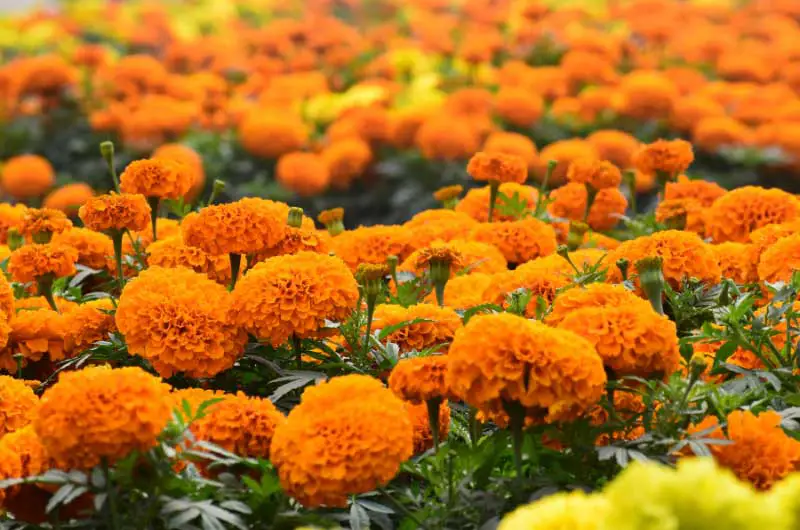Are Marigolds perennial? (Answered)
Marigolds are bright orange, yellow, and copper flowers that are popular among gardeners around the globe. These subtropical plants are tough and famous for their distinct pungent smell. This smell keeps the pests and insects away. These low-maintenance and no-fuss plants thrive in the bright sun.
A common question surrounding the Marigolds is whether they are annuals or perennial?
Most of the varieties of Marigolds are annual. It means they will bloom for a single season and die as the winter knocks on the door. But it may happen that they shed the seeds and can reseed themselves again the following year. However, some perennial varieties of Marigolds also do exist.

What are annuals and perennials?
Let’s first understand the two terms:
- Annuals
These plants complete their entire life cycle in one growing season. Their lifespan is less than a year.
- Perennials
These plants take many years to complete their life cycle.
Species of Marigolds
Various species of Marigolds show different behavior. Here is how some common varieties complete their life cycle:
1. African Marigolds
- Annuals
- They are also called by the name AZTEC/American Marigold
- Tall varieties- one to three feet tall
- Deer resistant
2. French Marigolds
- Annuals
- Among the most common varieties blooming in the fall and summer season
- The ideal temperature requirement is 70-75° F.
- Can grow up to a height of six to twelve inches
- Have the longest growing season
- Deer resistant
- Drought tolerant
3. Mexican/Spanish tarragon
- Perennial
- Has broad, flat flowers
- Tall variety-four to six feet
- Drought tolerant
- Deer resistant
- Their foliage has an aroma attracting butterflies and bees
- Thrives in full sun
4. Signet Marigolds
- Edible(sprinkled on salads)
- Requires plenty of sunlight
- Best used as mosquito repellent
5. Lemmon’s Marigolds
- Perennial
6. Mountain Marigolds
- Perennial
How can you prolong the blooming season of Marigolds?
You can easily prolong their blooming season just by following these simple hacks:
- You can deadhead the fading blossoms regularly. It will allow the plant to produce the new blooms more efficiently.
- As the Marigolds are self-sowing plants, you can drop the dead flowers and seeds into the soil. It will aid in the growth of new plants.
- They are prolific growers, so you will get to see the new flowers within a few weeks.
- This way, you will have plants at different stages of development or maturity and hence a long blooming season.
Tips for healthy growth of Marigolds
Marigolds are extremely easy-growing plants. You just need to water them and deadhead the spent flowers to let them bloom. Here are a few tips to take appropriate care of them:
Temperatures and light requirements
Plant your Marigolds in full sun to let the vibrant flowers bloom. Six hours of direct sunlight is what they crave. However, they can tolerate partial sunlight if direct sunlight isn’t available.
Marigolds aren’t zone-specific, like many other plants. They can readily grow in 2-11 zones.
However, not all species of Marigolds are frost-tolerant. So they die when the winters arrive.
Soil
As mentioned, they are prolific growers to thrive in any quality of soil or any soil pH. But if you are using clay soil or a similar kind of soil, it will not allow proper drainage and promote root rot.
Hence, you should use a soil type that contains plenty of organic material like loam mixture or sand to ensure proper soil drainage. You can add drainage aids like perlite or any other of your choice.
Regular mulching is recommended to regulate soil moisture and prevent weed growth.
Water/Humidity
Marigolds do not like to be watered in plenty. Also, try to water them only at their base, not on the foliages, because wet foliages attract powdery mildew.
Provide sufficient moisture to the soil by watering deeply. But allow the soil to dry between two watering sessions to avoid root rot.
Provide support
Tall varieties of Marigolds like ‘Striped Marvel’ and Deep Orange Lady’ can grow up to a height of 2-3 feet and need support. Stacking is an excellent way to support them.
Fertilizer
As most of the Marigold varieties are annuals, you don’t need to fertilize them throughout the growing season repeatedly. You can mix your soil with organic fertilizer and compost before planting the Marigolds in.
Avoid adding fertilizer during their growing cycle. Also, over-fertilization can cause excessive foliage growth and reduced growth of bloom. So try not to overfeed fertilizer to your Marigolds.
Common problems associated with growing Marigolds
Though they are fast growers and keep the pests at bay, you can still face several issues growing them. Read to know their problems and solutions:
Unusual growth
In some cases, your plant may produce ample foliages but fewer flowers. It is due to the overuse of fertilizer in the growing season.
Solution–
- Add the appropriate amount of fertilizer.
- Don’t add fertilizer in the mid-season; instead, add them before planting the Marigolds.
The second case is that your plant isn’t producing flowers at all. In such a scenario, check for the weather. If the surroundings are too hot, your Marigolds will invest all their energy to stay alive rather than bloom.
Solution–
- Add mulch around your plant’s base. It will help lower the soil’s temperature.
Pests
Though it’s a good pest repellent, some pests can still find it attractive. For example:
- Spider mites
You can quickly notice them by looking at the web that they create on the plants. They cause stippled marks and leaf discoloration.
- Aphids
Aphids usually don’t love these plants, but they can definitely attack them if food is scarce. It can cause leaf curling and distortion.
- Leafhoppers
They also cause deformed and discolored leaves. Besides, they can also spread yellow aster disease.
Solution–
- A standard solution to keep these pests under control is to spray insecticidal soap on the infected plant.
- Neem oil is equally effective.
- Caterpillars
Caterpillars love to nibble on the leaves and flowers of Marigolds.
- Slugs/snails
They absolutely love to chew off your Marigolds. You can add slug and snail bait to knock out their population.
- Other plant bugs
Infestation by tarnished plant bugs causes deformed or dwarfed flowers.
Solution-
- You have to spray insecticidal soap in combination with pyrethrin.
Diseases
Marigolds are resistant to most diseases, but that’s worrisome if they contract any disease. Read below to find out the treatable and untreatable diseases your Marigold can contract:
1. Treatable diseases
Powdery mildew
Symptoms:
- A powdery white substance on the leaves.
- Caused due to over moisture.
Treatment:
- Don’t overwater.
- Keep the plant dry.
- Water below foliages.
- Spray neem oil.
Botrytis cinerea
Symptoms:
- Grey spots on leaves.
Treatment:
- Remove and throw away the infected part.
2. Untreatable diseases
Fusarium
Symptoms:
- Plants are falling or damping off.
- Stunted growth
- Plant turns yellow
Aster yellows
Symptoms:
- Spread by aphids and leafhoppers
- Deformed plant
- Plant turns yellowish-green
- Spindly and weak shoots
Cucumber mosaic virus
Symptoms:
- Spread by aphids
- Stunt growth of Marigolds
- Distorted and discolored leaves
Phytophthora root, crown, stem rots
Symptoms:
- Mushy roots
- Dark lesions on the stem
Advantages of growing Marigolds
Some advantages of growing these beautiful bright colored flowers are:
- Easy maintenance
- Longer growing season
- Keep the pests like Mexican beetles away
- Edible (used as a food dye in some restaurants)
- Medicinal importance
- Decorative uses due to their size and beauty.
Thus we can conclude that Marigolds are annuals as well as perennials depending on their variety and their growing environment. If you are a first-time gardener you should definitely try growing these beautiful plants. They will grow in abundance and make you proud. So are you ready to grow some Marigolds this year?






